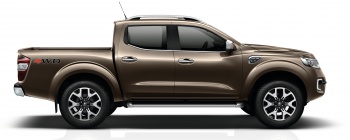
Why is it picking up?
The LCV market has seen substantial growth in the past five years, and it’s not only fleets and the burgeoning home delivery sector that have contributed to the trend. Over in the pick-up sector things are also, well, picking up, with more manufacturers introducing new model offerings.
In recent history, typical pick-up customers tended to be those in the market for a private use recreational or utility vehicle. But this is changing, with transport companies now looking more closely at the sector.
And manufacturers have responded. At the CV Show in April this year, for example, there were new offerings from Isuzu, Toyota, Fiat Professional, Ssangyong and Ford on display and more plans have been announced since.
The opportunity is significant, with global pick-up sales now amounting to an annual five million units more than one-third of total LCV sales, according to sales data including that from the SMMT, ACEA and the Alliance of Automobile Manufacturers (USA). The world’s best-selling pick-up is the Ford F-Series, closely tailed by the Chevrolet Silverado and the Toyota Hilux, though only the latter is sold in the UK.
In the UK alone, there has been steady growth in the market over the past two years. According to SMMT new vehicle registration figures, June 2016 saw 4,219 vehicles registered, a 17.3% increase on the same month in 2015, and more than 1,000 units up on June 2014. For the period January to June 2016, 22,893 pickups were registered, up 10.9% on the same period in 2015. The latest rolling year figure is 42,844 vehicles, up from 37,584 at the same time 12 months prior.
In contrast, the sub 2-tonne van sector is contracting (unlike the 2-3.5-tonne sector) and its numbers are now dwarfed by pick-up volumes, which might explain where some of the extra demand has come from. There has also been the emergence of crew cabs on pick-ups, giving the ability to carry more people, which can also bring down costs by reducing the number of vehicles on the fleet.
There is also more choice, with new entrants into the market rivalling the more established players. The recently re-launched Toyota Hilux might be on its eighth iteration, but most of the other contenders are relative newcomers, Nissan Navara, Ford Ranger and Mitsubishi L200 to name just three. And that’s before you factor in the forthcoming Mercedes-Benz and Renault offerings, as well as revisions to existing products such as the Volkswagen Amarok, which goes on sale in September.
Pick-ups have come a long way since early examples, which while often quite basic agricultural-type vehicles, suited the then customer base’s appetite for utility. Now, however, drivers have different standards and demands, and vehicles need to feature comfort levels on a par with other models in the manufacturer’s range, while retaining the versatility and usefulness that makes them so appealing to fleets.
A good example of this trend is Europe’s most popular pick-up, the Hilux, the latest version of which Toyota has just this month launched. It comes with a higher quality interior, stiffer chassis and more efficient powertrain. Improvements such as these are making pickups become more like cars to drive than ever before and, therefore, more wide-ranging in appeal.
Unlike the Hilux, the Mercedes-Benz pickup won’t be available to buy for a while. But when it does arrive, the first mid-size vehicle of its kind from a premium marque won’t disappoint, says the manufacturer. The company is the only vehicle maker to have a full range of passenger cars and commercial vehicles under one brand.
Volker Mornhinweg, Head of Mercedes-Benz Vans, says, “As part of our ‘Mercedes-Benz Vans goes global’ strategy, the pick-up is the ideal vehicle for the international expansion of our product range with a newly developed model.
“We can perfectly serve customers looking for a vehicle that offers a high level of utility and at the same time has the comfort, safety, and design of a Mercedes-Benz passenger car. We will design our brand’s first pick-up according to this recipe for success.”
Elsewhere, after introducing the Dacia Duster Oroch half-tonne SUV in Latin America, Renault has revealed plans for a global one-tonne pickup, the Alaskan. Helped by expertise from its partner Nissan, the French manufacturer believes that Alaskan and any pick-ups that follow will appeal to a worldwide audience.
“This pick-up will fulfil the needs of professional users and individual customers across the world,” says Ashwani Gupta – VP, global head of light commercial vehicles business at Renault. “With Alaskan, we are on track to take Renault’s LCV range forward from being a top regional player to a top global player.”
Time will tell whether Gupta’s vision becomes a reality, but one thing is for sure, there will be plenty of competition for the title of premier pick-up, and a market where growth shows no sign of abating.
Transport News Brief 21.7.16

 Click here to open the navigation menu
Click here to open the navigation menu